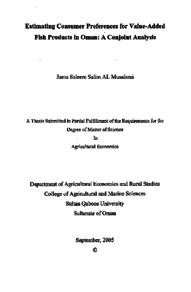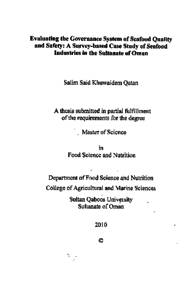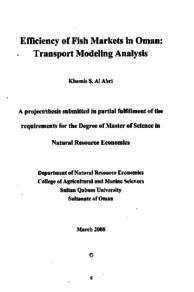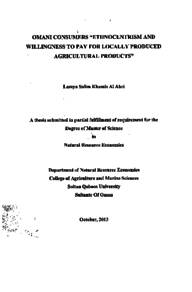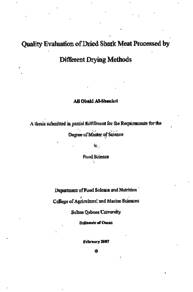Document
Estimating consumer preferences for value-added fish products in Oman : a conjoint analysis
Publisher
Sultan Qaboos University
Gregorian
2005
Language
English
English abstract
In Oman there are now as many as 40 export-oriented fish processing companies operating in the market, with five commercial companies running modern fleets. However, fish production in Oman is still a small-scale and low profile business activity. Competition in both local and international markets for the food business requires the development of differentiated products in order to meet the demand of more quality-stringent, health conscious, and attribute oriented consumers. The development of quality value-added fish products for some local or international markets could be a profitable business opportunity for fish processing companies in Oman. The objectives of this study are to evaluate consumers' preferences for value added fish products in Oman and to identify the most important attributes that are preferred by consumers. The study uses Conjoint Analysis method to estimate consumer preferences for value-added fish products on the basis of four attributes: form of the product, package size, method of cooking and the price. A questionnaire was designed and administered to 200 consumers from four major supermarkets in the Muscat region to conduct the conjoint experiment. Ordinary Least Square (OLS) Regressions is used to estimate the total utility for the consumers. The questionnaire results show that sixty percent (60%) of the respondents indicated that they or a member of their household do not eat value added fish products. Forty percent (40%) of the respondents agreed, that "value added fish products are a good alternative for similar meat and chicken products" and seventy three percent (73% of consumers are willing to buy value added fish products if safety is assured.
Results of the Conjoint Analysis show that the most important attribute in the purchasing decision of the consumer is the cooking method, which contributes 79.21% to the overall preference, whereas the least important attribute is the price, contributing only 0.34% to overall preference. The most preferred product is a finger or nugget fish form formulated for frying and packaged in a small package, whereas the least preferred product consists of the burger form formulated for micro-waving and packaged in large or medium packages. Segmentation of the value added fish market according to nationality shows that there is no significant difference between Omani's and non-Omani's preference structure. This study is among the first of its kind in Oman. Its results help provide useful information to fish processors to design and develop products that meet consumers preferences.
Description
Thesis
Member of
Resource URL
Arabic abstract
في سلطنة عمان هناك الآن ما يقارب من 40 شركة مهتمة بتصدير الأسماك ، من بينها 5 شركات فقط تدير أساطيل صيد حديثة. إذ مازال إنتاج وصيد الأسماك في عمان يعتبر نشاط تجاري ضيق النطاق، و المنافسة في الأسواق المحلية والدولية تتطلب تطوير المنتجات الغذائية المتنوعة وذلك لتلبية الطلب المتعلق بالجودة والسلامة والخصائص التي يرغب فيها المستهلك. أن تطوير بعض المنتجات السمكية ذات القيمة المضافة للأسواق المحلية أو العالمية يمكن أن يكون فرصة استثمارية مربحة لشركات التصنيع السمكي في السلطنة. إن الهدف من هذه الدراسة هو تقييم رغبة المستهلكين للمنتجات السمكية ذات القيمة المضافة في عمان وكذلك التعرف على أهم الخصائص المفضلة لدى المستهلكون. تستخدم الدراسة طريقة التحليل المريوط التقييم الفائدة أو المنفعة الكلية للمستهلكين للمنتجات السمكية ذات القيمة المضافة على أساس أربع خصائص وهي شكل المنتج ، حجم العبوة ، طريقة الطبخ وسعر المنتج. كذلك استخدمت الدراسة طريقة الانحدار الخطي العادي لحساب الفائدة الكلية للمستهلكين. تم تصميم استبانه وتم توزيعها على ۲۰۰ مستهلك تم اختيارهم من أربع مراكز تسوق بمحافظة مسقط أوضحت نتائج الاستبيان أن 60 % من المستهلكين لا يفضلون تناول المنتجات السمكية ذات القيمة المضافة. أشارت النتائج أيضا أن 40 % منهم يوافقون على أن هذه المنتجات هي بديل جيد للمنتجات الشبيهة من اللحوم والدجاج. فيما أبدی ۷۳% من المستهلكين رغبتهم بشراء هذه المنتجات في حال وجود ضمانات تؤكد سلامتها. تشير نتائج الدراسة بان الخاصية الأكثر أهمية في قرار الشراء للمستهلكين لهذه المنتجات هي طريقة الطبخ والتي مثلت ما نسبته ۷۹٫۲۱ % من المعدل العام لرغبة المستهلكين في حين وجد أن الخاصية الأقل أهمية في قرار الشراء للمستهلكين هي سعر هذه المنتجات والتي مثلت ما نسبته ۰٫34% فقط من المعدل العام لرغبة المستهلكين .أيضا وجدت الدراسة أن المنتج الأكثر تفضيلا هو أصابع السمك المعدة للقلي والمغلفة في عبوة صغيرة. في حين وجد أن المنتج الأقل تفضيلا هو برجر السمك المعد للطهي بواسطة المايكرويف والمغلف في عبوات متوسطة وكبيرة. وجدت الدراسة كذلك أن تقسيم المستهلكين إلى شريحتين طبقا للجنسية ( عمانيين وغير عمانيين ) لم يمثل اختلافا مهما في تقييم رغبة مستهلكي المنتجات السمكية ذات القيمة المضافة . تعتبر هذه الدراسة من أوائل الدراسات في هذا المجال في عمان. إن نتائج هذه الدراسة تقدم معلومات مفيدة لشركات التصنيع السمكي لتصميم وتطوير منتجاتها بناء على رغبات المستهلكين.
Category
Theses and Dissertations

